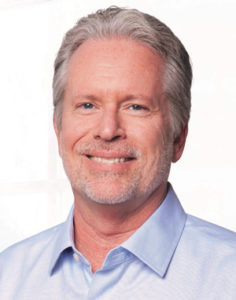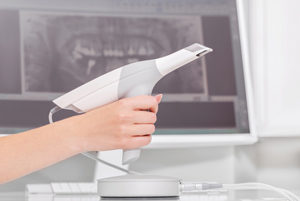By Laura Thill
Implementing new technology may be challenging, but the alternative is worse.
There’s no shortage of new technology for today’s dental professionals. For dental service organizations (DSOs), the challenge is to evaluate the market – both clinically and with regard to cost – to determine which solutions will help their clients provide the best possible patient care, at a reasonable cost, while enabling them to grow their practice and maintain their competitive edge in years to come.

At Pacific Dental Services® (PDS), “any technologies or equipment we consider to inculcate must add something of value to our overall patient care delivery system, including improved clinical outcomes, better pricing, enhanced patient convenience and/or greater efficiency,” says Charles Rodgers, DDS, vice president of clinical quality, PDS.
“Dentists in general are very gadget-focused,” he continues. “Visit any dental convention and you will immediately see this is true. When evaluating new technologies, PDS will only evaluate perhaps two out of 10 items seen at a convention. Ultimately, we might pick one out of 10 to actually implement. And, the choice we pick must provide superior clinical outcomes, better pricing, enhanced patient convenience, greater efficiency or some combination thereof.”
At the same time, PDS makes decisions that are most likely to foster their dental clients’ future growth. “When looking at equipment or technologies we could easily decide to choose whatever is least expensive, and in some cases, this may be the right choice,” Rodgers explains. “However, it is far better to first evaluate what is the best match for where we are headed in five years, or even 10 years.
“For the past three years, PDS has been building roughly 70 new supported offices each year,” he says. Rather than purchasing the most economical panorex machines, the DSO has selected those that are upgradable to cone beam. “This allows the owner dentists at the location to choose when to pursue 3D imaging.” Similarly, rather than acquiring older ovens for firing CEREC crowns, PDS has opted to buy furnaces that can sinter Zirconia. “This allows the owner dentists at the location to choose when they want to provide in-office Zirconia restorations. We refer to these offices as cone-beam- and Zirconia-ready.”
In addition to enabling dentists to provide optimal patient care, technologies such as CAD/CAM, diode lasers and CBCT often spark patients’ curiosity, Rodgers points out. When patients are interested in learning about a particular technology, it can lead to their acceptance of proposed treatments, he adds.
Across the board
 Although the value of incorporating a new technology across a DSO may be clear, it’s sometimes easier said than done. “Admittedly it can be difficult to incorporate a new technology across a large DSO,” says Rodgers. A disruptive technology may take months or longer to completely embrace, and providers, users and the support team must be educated to support and maintain it. Sometimes updates are required while the technology is still being rolled out, requiring the dental offices that just received the new technology to be retrofitted.
Although the value of incorporating a new technology across a DSO may be clear, it’s sometimes easier said than done. “Admittedly it can be difficult to incorporate a new technology across a large DSO,” says Rodgers. A disruptive technology may take months or longer to completely embrace, and providers, users and the support team must be educated to support and maintain it. Sometimes updates are required while the technology is still being rolled out, requiring the dental offices that just received the new technology to be retrofitted.
Occasionally, the dental office may need to make changes to accommodate a new technology, such as updating its electrical circuit, installing larger shelf space or expanding intranet pipelines, notes Rodgers. Sometimes, new systems crash soon after they are implemented at multiple locations. “Any technology that is core to the practice will require a dedicated team to support and maintain it. This support team will also need to track any upgrades to the technologies, which may require additional learning, travel, attending specific meetings or conventions, etc.”
At the same time, the DSO must evaluate how practical it is to equip all of its dental offices with the same technology. “Ideally every office would have similar and integrated equipment or technology,” says Rodgers. When more offices pull together to purchase the same equipment, the better leverage a group can have with preferred vendors, he points out. “But this can be impractical or impossible to achieve,” he adds.
“At each PDS-supported office, owner dentists have a great deal of autonomy, so we have learned to accommodate the variation that exists with material and technology choices,” says Rodgers. Even so, the PDS National Dental Advisory Board (comprised of practicing dentists) encourages dental members to make a selection from two or three equipment solutions. “For instance, consider an item as simple as a curing light. Many of our older supported offices may be using a curing light that is not even manufactured anymore. So, of course, not every office is using the same curing light. When an old curing light finally breaks, however, the office is able to get the latest upgraded version of the same model, or choose between two other similarly priced, capable options, which have been vetted and identified as preferred choices.”
That said, dentists sometimes question how PDS can offer better quality materials at a lower cost. “A perfect example of this is in the CAD/CAM arena – specifically Dentsply Sirona’s CEREC system,” says Rodgers. “Almost every PDS-supported practice has a CEREC imaging unit and milling machine in its office, permitting crown restorations to be completed in a single day. This not only enhances patient convenience, but also reduces lab and supply costs. We can consistently achieve this four out of five times. But, there is still that one time when the patient and/or the dentist requests a lab-based crown for various reasons. In these cases, the image can be sent directly to the lab.
“While implementing new technologies can be challenging, the risk of not continually adding the appropriate technologies to our supported practices is too huge to ignore,” says Rodgers. For instance, the office that has not committed to CAD/CAM at this level will – at the very least – require the ability to take digital impressions in order to remain competitive, he points out. “These images may be sent to a central milling location or a preferred dental lab, and the turnaround time for the completed restoration may only be a few days.
“Still, dentists who continue to use traditional impression materials, such as polyvinyl siloxane (PVS), are already being left behind,” he continues. “Every big dental lab converts that PVS impression into a digital format when they receive it (either digitally inverted from the impression or scanned from the first model) and the work flow remains digital throughout the rest of the lab journey.”
Evaluating new technology for dental members comes down to seeking “the appropriate technologies that align with our ideal future state to allow the best delivery of quality patient care,” he says.

